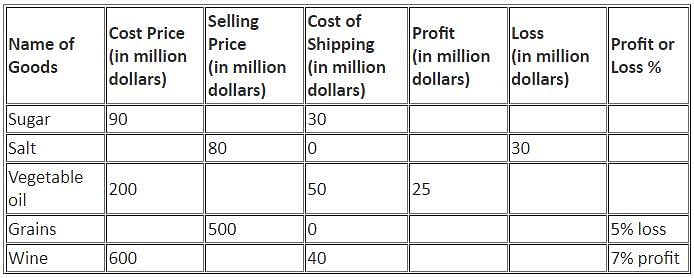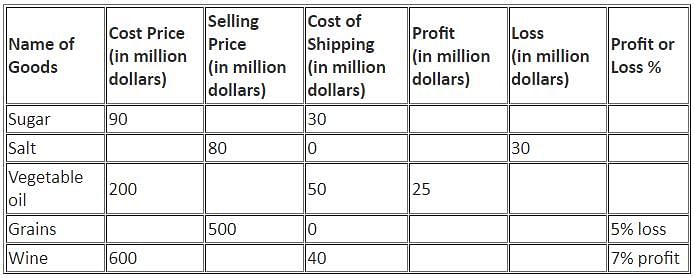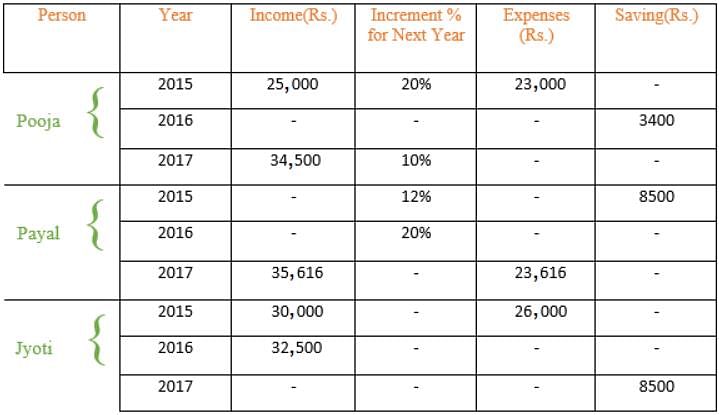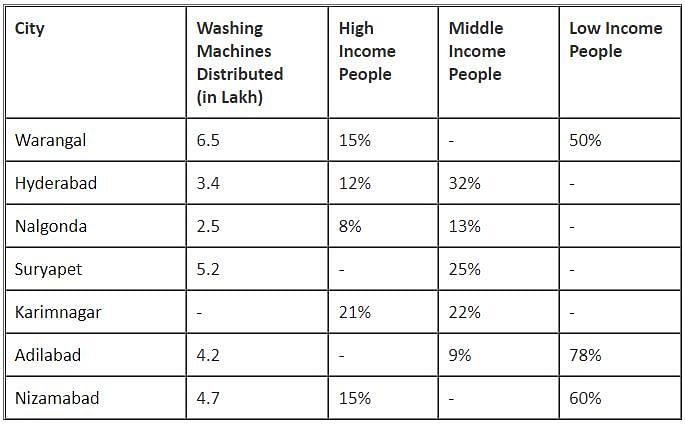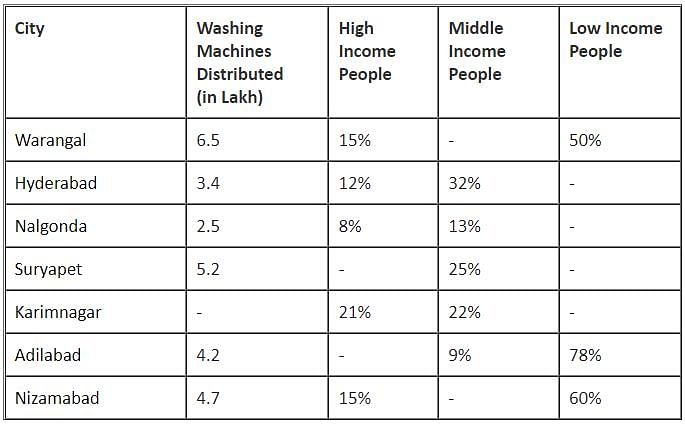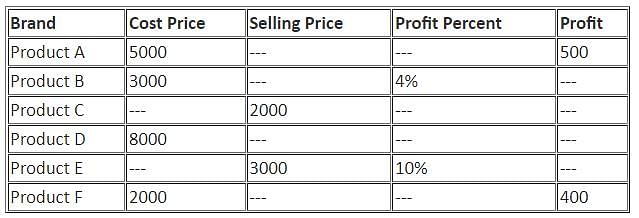This EduRev document offers 15 Multiple Choice Questions (MCQs) from the topic Missing Data (Level - 1). These questions are of Level - 1 difficulty and will assist you in the preparation of CAT & other MBA exams. You can practice/attempt these CAT Multiple Choice Questions (MCQs) and check the explanations for a better understanding of the topic.
Question for Practice Questions Level 1: Missing Data
Try yourself:Directions: Study the following information and answer the question that follows.
The table below shows the percentage profit or loss of five different commodities based on the sum of cost price and shipping cost.

Explanation
Selling price of Vegetable oil = 200 + 50 + 25 = $275 million
Cost price of salt = Selling price + Loss = 80 + 30 = $110 million
Therefore, required percentage = 275/110 x 110 = 250%
Report a problem
Question for Practice Questions Level 1: Missing Data
Try yourself:Directions: Study the following information and answer the question that follows.
The table below shows the percentage profit or loss of five different commodities based on the sum of cost price and shipping cost.

Q. What is the difference between the selling price of Wine and that of Vegetable oil?
Explanation
Total cost price of Wine = 600 + 40 = $640 million
Selling price of Wine = 100 + Profit Percent/100 x CP
= 100 + 7/100 x 640 = $684.8 million
Selling price of Vegetable oil = 200 + 50 + 25 = $275 million
Therefore, required difference = 684.8 - 275 = $409.8 million
Report a problem
Question for Practice Questions Level 1: Missing Data
Try yourself:Directions: Study the following information and answer the question that follows.
The table below shows the percentage profit or loss of five different commodities based on the sum of cost price and shipping cost.

Q. What is the ratio of the loss on Grains to that on Salt?
Explanation
Cost price of Grains = 100/100 - Loss Percent x SP
= 100/100 -5 x 500 = 100/95 x 500 million
Loss on Grains = CP of Grains - SP of Grains = 50000/95 - 500 = 2500/95 million
Loss on Salt = $30 million
Therefore, required ratio = 2500/95 : 30 = 50 : 57
Report a problem
Question for Practice Questions Level 1: Missing Data
Try yourself:Directions: Study the given information and answer the following question.
The table given below shows the estimated cost (in Rs. lakh) of a project of laying a railway line between two places, the project began in 1988 and was completed in 1991.

Q. How many times approximately was the total cost of materials to the total labour cost for all the years?
Explanation
Total material cost = (95 + 80 + 75 + 70 + 45 + 60 + 15 + 12 + 16 + 25 + 18 + 21) = 532
Total labour cost = (2.1 + 25 + 20 + 18) = 65.1
Therefore, total material cost was approximately 8 times the total labour cost.
Report a problem
Question for Practice Questions Level 1: Missing Data
Try yourself:Directions: Study the given information and answer the following question.
The table given below shows the estimated cost (in Rs. lakh) of a project of laying a railway line between two places, the project began in 1988 and was completed in 1991.

Q. The total expenditure was required to be kept within Rs. 700 lakh by cutting the expenditure on administration equally in all the years. What was the percentage cut on administration expenditure for the year 1989?
Explanation
Total expenditure = 52.1 + 267.5 + 196.4 + 209.5 = Rs. 725.5 lakh
If total expenditure was to be kept within 700 lakh, it had to be reduced by Rs. 25.5 lakh
So, the expenditure reduced each year would have been (25.5/4) = Rs. 6.375 lakh
Hence, percentage cut for 1989 = (6.375/15) × 100 = 42.5%
Report a problem
Question for Practice Questions Level 1: Missing Data
Try yourself:Directions: Study the given information and answer the following question.
The table given below shows the estimated cost (in Rs. lakh) of a project of laying a railway line between two places, the project began in 1988 and was completed in 1991.

Q. If the length of line to be laid each year was in proportion to the estimated cost for material and labour, what fraction of the total length was proposed to be completed by the third year?
Explanation
Costs of material and labour in:
1988 = Rs. 2.1 lakh
1989 = 95 + 70 + 15 + 25 + 25 = Rs. 230 lakh
1990 = 80 + 45 + 12 + 18 + 20 = Rs. 175 lakh
1991 = 75 + 60 + 16 + 21 + 18 = Rs. 190 lakh
Therefore, fraction of the total length proposed to be completed by the third year = (2.1 + 230 + 175)/(2.1 + 230 + 175 + 190) = 0.7
Report a problem
Question for Practice Questions Level 1: Missing Data
Try yourself:Directions: Study the following information carefully and answer the question given below.
Table shows income, increment percentage, expenses and saving details of three employees for three years (2015, 2016 and 2017).

Q. If the difference between the expenses and savings of Jyoti in 2017 is Rs. 16,750, then what is the increment percentage in the total income of Jyoti from 2015 to 2017?
Explanation
Expenses of Jyoti in 2017 = Rs. (8500 + 16,750) = Rs. 25,250
Income of Jyoti in 2017 = Rs. (25,250 + 8500) = Rs. 33,750
Income of Jyoti in 2015 = Rs. 30,000
Increment percentage = 33750 - 30000/30000 x 100 = 12.5%
Report a problem
Question for Practice Questions Level 1: Missing Data
Try yourself:Directions: Study the following information carefully and answer the question given below.
Table shows income, increment percentage, expenses and saving details of three employees for three years (2015, 2016 and 2017).

Q. If the income of Pooja in 2015 is doubled and the percentage increment of Pooja in the year 2016 is also doubled, then what is the income of Pooja in 2017?
Explanation
Income of Pooja in 2015 = Rs. 25,000
Income of Pooja in 2016 = 120% of Rs. 25,000 = Rs. 30,000
Income of Pooja in 2017 = Rs. 34,500
% increment in 2016 = [(34,500 - 30,000)/30,000] × 100 = 15%
Now, after changing the value of increment in 2016 and income in 2015 of Pooja as per the question,
Income of Pooja in 2015 = Rs. 25,000 × 2 = Rs. 50,000
Income of Pooja in 2016 = Rs. 50,000 × 120/100 = Rs. 60,000
Income of Pooja in 2017 = Rs. 60,000 × 130/100 = Rs. 78,000
Hence, the income of Pooja in 2017 is Rs. 78,000.
Report a problem
Question for Practice Questions Level 1: Missing Data
Try yourself:Directions: Study the following information carefully and answer the question given below.
Table shows income, increment percentage, expenses and saving details of three employees for three years (2015, 2016 and 2017).

Q. Income of Pooja in 2016 is approximately what percentage more/less than the average income of Pooja?
Explanation
Income of Pooja in 2015 = Rs. 25,000
Income of Pooja in 2016 = Rs. 25,000 × 120/100 = Rs. 30,000
Income of Pooja in 2017 = Rs. 34,500
Average income of Pooja = Rs. (25,000 + 30,000 + 34,500)/3 = Rs. 29,833.3
Required percentage = 30,000/29,833.3 x 100 = 100.56
Hence, income of Pooja in 2016 is approximately 0.56% more than average income of Pooja.
Report a problem
Question for Practice Questions Level 1: Missing Data
Try yourself:Directions: Study the following information carefully and answer the question given below.
Table shows income, increment percentage, expenses and saving details of three employees for three years (2015, 2016 and 2017).

Q. If the income of Pooja in 2015 is doubled and the percentage increment of Pooja in the year 2016 is also doubled, then what is the income of Pooja in 2017?
Explanation
Income of Pooja in 2015 = Rs. 25,000
Income of Pooja in 2016 = 120% of Rs. 25,000 = Rs. 30,000
Income of Pooja in 2017 = Rs. 34,500
% increment in 2016 = [(34,500 - 30,000)/30,000] × 100 = 15%
Now, after changing the value of increment in 2016 and income in 2015 of Pooja as per the question,
Income of Pooja in 2015 = Rs. 25,000 × 2 = Rs. 50,000
Income of Pooja in 2016 = Rs. 50,000 × 120/100 = Rs. 60,000
Income of Pooja in 2017 = Rs. 60,000 × 130/100 = Rs. 78,000
Hence, the income of Pooja in 2017 is Rs. 78,000.
Report a problem
Question for Practice Questions Level 1: Missing Data
Try yourself:Directions: Study the table given below and answer the following question.
Distribution of washing machines in different cities and among different categories of people of Telangana is as follows:
(Total washing machines distributed = 30 lakh)

Q. What is the difference between total distribution of washing machines in Warangal and total distribution of washing machines in Karimnagar and Adilabad together?
Explanation
Washing machine distribution in Warangal = 6.5 lakh
Washing machine distribution in Karimnagar = 30 - (6.5 + 3.4 + 2.5 + 5.2 + 4.2 + 4.7) = 3.5 lakh
Washing machine distribution in Adilabad = 4.2 lakh
Washing machine distribution in Karimnagar and Adilabad together = 3.5 + 4.2 = 7.7 lakh
Required answer = (7.7 - 6.5) lakh = 1,20,000
Report a problem
Question for Practice Questions Level 1: Missing Data
Try yourself:Directions: Study the table given below and answer the following question.
Distribution of washing machines in different cities and among different categories of people of Telangana is as follows:
(Total washing machines distributed = 30 lakh)

Q. In Suryapet city, the ratio of percent distribution of Washing Machines among high income people to that among low income people is 2 : 3. Then, how much more is the distribution of Washing Machines among high income people in the same city than that among middle income people?
Explanation
In Suryapet, High income people + Low income people = 100 - 25 = 75%
High income people : Low income people = 2 : 3
So, High income people % = 2/5 × 75 = 30%
Low income people % = 3/5 × 75 = 45%
Middle income people % = 25% (given)
Required answer = 5.2 × 30 - 25/100 = 0.26 lakh = 26,000
Report a problem
Question for Practice Questions Level 1: Missing Data
Try yourself:Directions: Study the table given below and answer the following question.
Distribution of washing machines in different cities and among different categories of people of Telangana is as follows:
(Total washing machines distributed = 30 lakh)

Q. What is the difference between the number of Washing Machines distributed among high income people of Nalgonda, Warangal and Nizamabad together and that distributed among middle income people of Suryapet, Karimnagar and Nizamabad together?
Explanation
Number of Washing Machines distributed among high income people of Nalgonda, Warangal and Nizamabad
= 2.5 × 8/100 + 6.5 x 15/100 + 4.7 x 15/100 = 1.88 lakh
Number of Washing Machines distributed among middle income people of Suryapet, Karimnagar and Nizamabad
= 5.2 × 25/100 + 3.5 × 22/100 + 4.7 × 25/100 = 3.245 lakh
Difference = (3.245 - 1.88) lakh = 1.365 lakh = 1,36,500
Report a problem
Question for Practice Questions Level 1: Missing Data
Try yourself:Directions: Study the following graph carefully and answer the question that follows:

Q. What is the profit or loss % of product C if cost price of product C is half the cost price of product D?
Explanation
Cost price of product D = Rs. 8000
Therefore, cost price of product C = Rs. 4000
Loss of product C = 4000 - 2000 = Rs. 2000
Loss percent of product C = (2000/4000) × 100 = 50%
Report a problem
Question for Practice Questions Level 1: Missing Data
Try yourself:Directions: Study the following graph carefully and answer the question that follows:

Q. What is the profit of product B?
Explanation
Profit of product B = 3000 × 0.04 = Rs. 120
Report a problem
